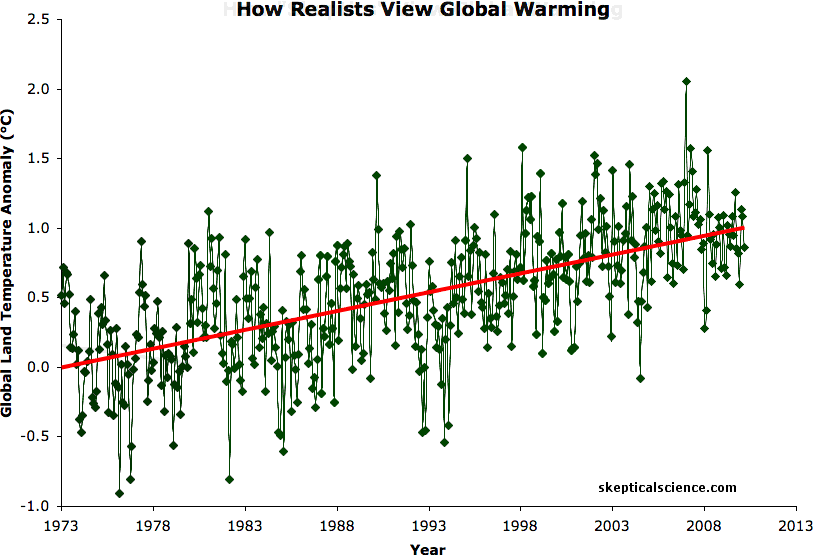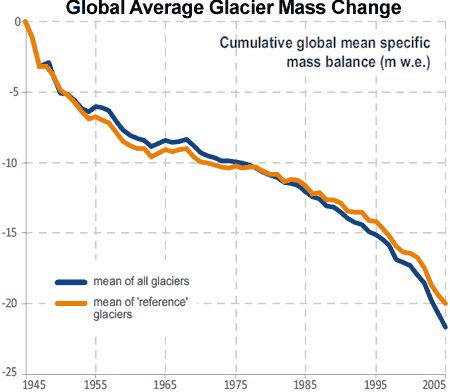
On his blog, Dr. Roger Pielke Sr. recently wrote proudly of a question and answer session he held with local high school students in Colorado. Educating students about climate science would indeed be a laudable enterprise, if done well. Unfortunately, in his answers to the students' questions, Dr. Pielke rather grossly misinformed and misled them. As we'll show in our analysis below, the problems with Dr. Pielke's answers were similar to those we identified during our own discourse with him - namely a cherrypicking of data, and an apparent desire to blame as much of global warming as possible on anything but CO2.
Question:
Is it true that the recent rise in Global Temperature is due to Carbon Dioxide [emissions]?
Pielke Answer:
The addition of CO2 to the atmosphere from human activities is a warming influence in terms of reducing the magnitude of heat lost to space over time. However, it is just one of a number of warming influences including from soot (black carbon), ozone, and other aerosol effects.
For those who want to read a summary of these other forcings (including cooling human effects), I recommend the National Academy of Science Report
National Research Council, 2005: Radiative forcing of climate change: Expanding the concept and addressing uncertainties. Committee on Radiative Forcing Effects on Climate Change, Climate Research Committee, Board on Atmospheric Sciences and Climate, Division on Earth and Life Studies, The National Academies Press, Washington, D.C., 208 pp.
What the Science Says:
At least Dr. Pielke has correctly explained the basic science of the increased greenhouse effect, but he has managed to simultaneously downplay the role of CO2 in the recent global warming. As we showed during our discourse with Dr. Pielke, the CO2 contribution to the global surface warming over the past century is 0.64 to 1.28°C, with a best estimate of 0.79°C, compared to the observed 0.8°C observed surface warming.
While it's certainly true that there are other forcings causing both warming and cooling, a more informative answer would have emphasized the dominant role of CO2 and other greenhouse gases in the recent warming trend. CO2 isn't just "a warming influence," it's the main warming driver. Moreover, greenhouse gases will dominate even more in the future as we continue to increase their atmospheric levels by burning fossil fuels.
Question:
If not [CO2], what led to this change in temperature?
Pielke Answer:
In addition to these human climate forcings, natural climate forcings and feedbacks are also quite important. We need to consider these natural effects as clearly the climate is much more complex than is commonly reported by the media and even the IPCC. For example, the global average temperature anomalies are cooling! See
What the Science Says:
As noted in our previous answer, CO2 has indeed been the dominant cause of the change in surface temperature over the past century. Dr. Pielke has once again failed to make this crucial point in his answer, instead choosing to tell these high school students that the media and IPCC are disregarding the complexity of 'natural effects' (without providing any evidence to support this assertion). Dr. Pielke then repeats the cherrypicking-based myth that global temperatures are cooling (see Figure 1, and also here and here, where we have already disproven this myth repeatedly for Dr. Pielke), and links to Bob Tisdale's "skeptic" blog.
Why Dr. Pielke links an obscure blog rather than referencing peer-reviewed literature is a mystery, and a climate scientist should be able to do much better. Dr. Pielke appears to be becoming a Tisdale cheerleader despite the fundamental flaws in Tisdale's weblog analyses. Additionally, Tisdale's blog doesn't even seem to support Pielke's false claim of cooling temperatures.
Figure 1: BEST land-only surface temperature data (green) with linear trends applied to the timeframes 1973 to 1980, 1980 to 1988, 1988 to 1995, 1995 to 2001, 1998 to 2005, 2002 to 2010 (blue), and 1973 to 2010 (red). Created by Dana Nuccitelli. Hat-tip to Skeptical Science contributor Sphaerica for identifying all of these "cooling trends."
Question:
If the human [population] continues to release carbon dioxide into the atmosphere at this rate, or even at an increased rate, what do you predict the effects on the global temperature will be?
Pielke Answer:
Since the CO2 effect is but one of a number of first order climate influences, as discussed above, I have concluded we know much less about the future climate than is claimed by the IPCC and the media. This does not mean we should not be concerned as to how much CO2 we insert into the atmosphere, but the claims that we know its effect on the climate is very much overstated, in my view.
What the Science Says:
Dr. Pielke has failed to even answer the question in this case, which is quite simple. If CO2 emissions continue to rise, their warming effect will continue to rise as well. Instead Dr. Pielke has once again chosen to downplay the role of CO2 in climate change. If Dr. Pielke's goal is to achieve greenhouse gas emissions reductions, as he suggests in his answer and has previously confirmed in his discussions with Skeptical Science, telling a group of high school students that the role of CO2 is overstated is the wrong way to achieve this goal. In fact, as we demonstrated to Dr. Pielke, the warming effects of CO2 are quite well understood.
Additionally, this is the second answer in which Dr. Pielke has effectively equated the IPCC and media, which is rather insulting to the IPCC. Moreover, the IPCC does not conduct original research, but rather summarizes the most up-to-date research. It's not the IPCC's confidence about future climate change, it's Dr. Pielke's peers'.
Question:
The melting of the polar ice caps and glaciers worldwide has the world significantly alarmed. Can the melting of these formations be contributed to Global Warming?
Pielke Answer:
Melting is a response to warming. However, not all glaciers and ice caps are melting. While the Arctic ice, for example, has been decreasing in areal extent; see
http://arctic.atmos.uiuc.edu/cryosphere/IMAGES/seaice.anomaly.arctic.png
Antarctic sea ice coverage has not; see
http://arctic.atmos.uiuc.edu/cryosphere/IMAGES/seaice.anomaly.antarctic.png
What the Science Says:
This may be Dr. Pielke's worst answer of them all, and a red herring. Firstly, it's well worth noting that by admitting that the planet is warming, Dr. Pielke has contradicted his previous false assertion of cooling temperatures.
More importantly, while technically true that Antarctic sea ice extent has not declined, Dr. Pielke has failed to explain the reasons behind the Antarctic sea ice stability, and the fact that the Arctic sea ice decline (a.k.a. "Death Spiral") is far more rapid than the very slight Antarctic sea ice increase (which is not statistically significant) (Figure 2).
Figure 2: National Snow and Ice Data Center (NSIDC) Antarctic, Arctic, and global (sum of the two) sea ice extents with linear trends. The data is smoothed with a 12-month running average.
Dr. Pielke's answer gives the false impression that melting glaciers and ice caps are not a major concern, which could not be further from the truth. The decline in Arctic ice volume is even more rapid and concerning than the decline in extent - ice is three dimensional, after all. Loss of Arctic ice is also of great concern because of the resulting amplification effect - reflective ice giving way to dark oceans, causing more absorption of radiation and accelerated warming. ?
Additionally, ??Dr. Pielke has failed to discuss the rapid decline of land-based ice, which contributes to sea level rise. The mass of the Antarctic ice sheet, especially the West Antarctic Ice Sheet (WAIS) is declining. And he has neglected to mention that despite the slight increase in Antarctic sea ice extent, the Southern Ocean is warming - faster than the global trend, in fact. Then of course there's the rapid decline of the Greenland ice sheet, and the decline of glaciers around the globe (Figure 3).

Figure 3: Cumulative mass balance curves for the mean of all glaciers and 30 'reference' glaciers (WGMS 2008).
Dr. Pielke has depicted a far-too-rosy picture in his answer to this question, to say the least. This sort of answer is one we would expect from the likes of Christopher Monckton, not a climate scientist, and especially not in response to a question from a student trying to learn about climate change impacts.
Question:
In your scientific opinion, does Global Warming exist?
Pielke Answer:
Global warming is an oversimplification of the actual behavior of the climate system. See, for example, my weblog post on this topic at
Finally, in terms of climate metrics, I encourage your class to research yourselves from [original] data what is the current status of these metrics. You would be surprised how many of them do not follow the behavior predicted by the multi-decadal global climate model predictions, and being reported in the news.
What the Science Says:
It's difficult to come up with an answer to "does global warming exist?" other than "yes," but somehow Dr. Pielke has managed. Instead, Dr. Pielke directs the students to a blog post in which he argues that ocean heat content (OHC) should be the metric by which global warming is measured. However, Dr. Pielke fails to mention that OHC and total global heat content have been increasing as well (Figure 3), and thus even by his preferred measure, the answer is still undeniably "yes."
Figure 3: Total Global Heat Content (data from Church et al. 2011)
Rather than correctly answer the question, Dr. Pielke chooses to push one of his pet arguments (using OHC to monitor global warming) instead. How is this an appropriate way to educate students?
Additionally, contrary to Dr. Pielke's final assertion in this answer, climate models do simulate most climate metrics well when they include all forcings, such as volcanism, for example. See Domingues et al. (2008):
"On average, the decadal variability of the climate models with volcanic forcing now agrees approximately with the observations, but the modelled multi-decadal trends are smaller than observed."
Also see a new paper by Fyfe et al. (2011).
Overall, Dr. Pielke's answers to these high school students' questions are nothing to be proud of. Rather than providing straightforward scientific answers, Dr. Pielke has chosen to misinform these students with a number of his pet climate myths (that global warming has magically stopped, that it's mostly caused by anything but CO2, that it's not an urgent concern, and that OHC should be the global warming metric).
At the very least Dr. Pielke could have explained the mainstream scientific answers to these questions, and then explained why his opinions differ; instead he only provided his outlying views. We can only hope that these students are not relying on Dr. Pielke as their sole source of climate science information, or they will have been woefully misinformed. Dr. Pielke should be embarassed to provide such answers to impressionable students, and has done them a disservice.
Posted by dana1981 on Tuesday, 22 November, 2011
 |
The Skeptical Science website by Skeptical Science is licensed under a Creative Commons Attribution 3.0 Unported License. |